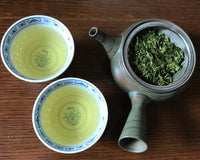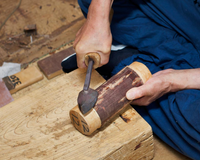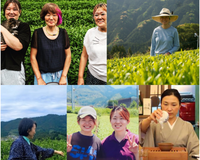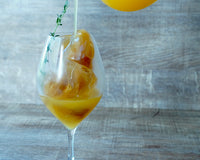-
Aracha – 荒茶 – Literally “coarse tea”. Japanese tea production can be understood (simplified) as harvest –> steam –> roll –> dry –> sort –> post-process. Aracha tea leaves are leaves that have been dried but remain unsorted. The sorting process separates the leaves from stems, fannings, and dust. True aracha also retains about 5% moisture and is not complete yet as a commercial product—refinement factories (who are also usually wholesale companies) will green-roast the aracha to reduce the moisture to 1-2% or so. Commercially available aracha, is generally green-roasted at least a little, but might remain unsorted.
Shop all Aracha -
Asamushicha – 浅蒸し茶 – Light-steamed tea, usually referring to sencha. In general, the highest quality teas are light-steamed, i.e. for about 30 seconds. This preserves the shape of the leaf. Chuumushi or Fukamushi (mid or deep steamed), breaks down the leaves making it easier to draw out more flavor so is used for leaves that are not as infused with the goodness that is tea.
Shop all Asamushicha -
Awa Bancha – 阿波番茶 – Awa Bancha is a slightly fermented bancha tea from Tokushima Prefecture that contains lactic acid, also known as milk acid, which gives the tea a slight pungency.
Shop all Awa Bancha -
Bancha – 番茶 – Literally “ordinary tea”, this refers to leaves that have been allowed to grow large for maximum volume (maximum crop yield), as a result, the catechin level is maxed making it very healthy but also more bitter. However, bancha is usually summer or autumn-harvested and therefore contains less overall catechin than spring harvested teas. Be warned, this definition of bancha is primarily used in Eastern Japan, where as the equivalent term would be Yanagi Bancha 柳番茶 in Western Japan (Kyoto etc). In Western Japan “bancha” would refer to roasted tea or hojicha.
Shop all Bancha -
Batabatacha – バタバタ茶 – A post-fermented tea that is usually drunk by whisking, batabatacha is produced in Toyama Prefecture on the coast of the Sea of Japan, batabatacha is served at events such as when introducing the bride after the wedding ceremonies in the region. A blend of herbs and tea from neighboring town of Itoigawa in Niigata Prefecture also uses the same name. "Batabata" refers the sound of whisking.
Shop all Batabatacha -
Botebotecha - ボテボテ茶 - A way of consuming tea that arose among the steel laborers of Shimane Prefecture in the Edo Period possibly in imitation of the Japanese tea ceremony. Tea is whisked up into a froth while standing, and various pieces of food are placed inside the tea. Then you drink the entire bowl...drinking the food as well as the tea.
Shop all Botebotecha -
Boucha – 棒茶 -Boucha or Bōcha (literally "stick tea") is another name for roasted kukicha (stem tea) and can be considered a subset of kukicha or hojicha. The stems used are USUALLY larger (either the center stems of large, mature leaves, or the stems to which the leaf is attached) and give the tea the appearance of sticks. May also be called Kuki Hojicha.
Shop all Boucha and Kuki Hojicha - Bukubukucha - ぶくぶく茶 - A method of whisking and drinking tea traditionally practiced in Okinawa, bancha or sanpincha is whisked into a mountain of foam, and drunk / eaten with a small amount of sekihan rice (rice with red beans).
- Cha – 茶 – Cha is a generic term for tea. It refers to all types of tea made frmo camellia sinensis, however, in Japan, the term “cha” is used for tisane/herbal teas as well.
- Chumushicha – 中蒸し茶 – Literally “mid-steamed tea”, refers to tea leaves that is in between Asamushi and Fukamushi (steam time is longer than Asamushi but shorter than Fukamushi). It could be said that Chumushicha is the standard tea. The leaves become smaller than Asamushi and the tea steeps greenish-yellow.
-
Fukamushicha – 深蒸し茶 -Literally “deep-steamed tea”, refers to tea leaves that have been steamed longer (for 1-3 minutes) than Asamushicha or Chumushicha. The tea leaves become more powdery compared to standard sencha, and as a result, the color of the tea steeps deeper-green with rich flavor.
Shop all Fukamushicha - Futsumushi - 普通蒸し - Ordinary or regular steaming. See Chumushicha.
-
Genmaicha – 玄米茶 – Genmaicha is a type of tea made by mixing sencha or bancha with toasted rice. Though there are different types, 1:1 ratio of toasted rice and bancha is regarded as the standard genmaicha. Because the tea leaf used is half the amount of usual tea, genmaicha contains less caffeine compared to sencha or other green tea.
Shop all Genmaicha -
Goishicha – 碁石茶 – Goishicha is Japan’s only fermented tea and made with a special method known as after fermentation. Made in Kochi Prefecture on the island of Shikoku, the name goishicha is taken from the Japanese game Igo. The tea has a bit sour taste.
Shop all Goishicha -
Guricha – ぐり茶 – Guricha is another name for tamaryokucha.
Shop all Guricha and Tamaryokucha - Gyokucha / Tamacha – 玉茶 – Literally “round tea” are teas made during the sencha rolling process. Usually teas are made into needle shape but instead some teas get rolled into balls. The tea itself is a sencha but can be steeped several times. It can also be eaten as a snack.
-
Gyokuro – 玉露 – Gyokuro is a type of sencha, but grown under a different condition; while sencha is grown under the full sun, gyokuro is shielded from the sun (shaded for approximately 20 days, but length vary by farmer and region). Catechin that causes bitterness in taste is decreased under the shade, and instead preserves a high L-theanin amino acid content. As a result, the umami taste in the tea increases.
Shop all Gyokuro
See Top 10 Best Selling Gyokuro 2021 -
Gyokushin – 玉真 – mecha (small leaf tips) filtered out from unrefined gyokuro during the gyokuro production processed. This name is used primarily in Kyoto.
Shop all Gyokushin -
Hojicha – 焙じ茶 – Roasted tea, generally roasted bancha green tea. However, the base leaf may be anything from spring leaf to stems to branches from autumn harvest. When non-green teas are roasted, in Japan, there is usually a qualification that it is a non-green tea, i.e. hoji kocha or roasted black tea.
Shop all Hojicha
See Top 10 Best Selling Hojicha 2021 - Ichoucha - 萎凋茶 - "withered tea". This refers to a green tea (generally a sencha) that has been slightly withered to create floral aromas but primarily retains its appearance, aroma, and flavor characteristics as a green tea.
- Ishizuchi Kurocha - 石鎚黒茶 - Literally "Stone Hammer Black Tea", this folk tea is named after Mt. Ishizuchi in Ehime Prefecture. A post-fermented tea, whole branches are cut from plants with large leaves in the summer, then steamed in a barrel until the leaves fall of the branches. The tea is fermented with mold from the Aspergillus genus for about a week, then lightly rolled, undergoes anaerobic fermentation again for 2-3 weeks using lactic acid bacteria, then finally sundried for 2-3 days.
-
Kamairicha – 釜炒り茶 – Kamairicha is made by heating the leaves in a pan instead of steaming. Many Chinese teas use this method to make green tea and has been practiced in Southern Japan for generations.
Shop all Kamairicha -
Kancha – 寒茶 – Literally "cold tea", this is a folk tea made from large, thick, mature tea leaves picked in the height of winter (Dec - Feb). There are several variations of this folk tea depending on the specific village in which it originates. In the Shishikui Village in the mountains of Tokushima Prefecture, Shikoku Island, for example, the picked leaves are made by steamed, rolled individually by hand, sundried, and rolled again. (See a short Japanese interview of farmer Akemi Ishimoto by Asahi Shimbun). In the Asuke Village of Ehime Prefecture, Shikoku Island, however, the leaves are not rolled at all, but steamed then sundried. Tea Farm Mitocha, based in the mountains of Nara, is currently making kancha in the style of Asuke Village.
Shop all Kancha -
Karigane – 雁 / 雁ヶ音 – Karigane refers to kukicha leaf stem tea made from gyokuro or high-grade sencha, and a term used mainly in the Kansai region (western Japan). Karigane is translated as “the sound of geese”, the motif geese symbolizing beauty in the traditional Japanese poetic aesthetic.
Shop all Karigane -
Kabusecha – 被せ茶 – Kabusecha is a tea that is categorized in between gyokuro and sencha. Shaded for approximately one week (after the leaves bud), it has a good balance of rich taste and savoriness.
Shop all Kabusecha -
Koicha – 濃茶 – Koicha is the term for matcha made to be very thick. In tea ceremony, koicha is made by putting three chashaku scoops of matcha in a bowl with small amount of warm water. It is more like kneading rather than whisking, creating a thick, dark matcha. Koicha is said to be the most important way to welcome and treat the guests. Often times the bowl is passed around among the guests where each guest take a sip. Practice may vary depending on the school of tea ceremony. (Read blog "Discover Koicha" to learn more)
Shop all Koicha -
Konacha – 粉茶 – Literally “powdered tea”, konacha is often confused with tea powder but it is actually a tea made up of smallest bits of tea leaves that are left after processing. It is known as a tea served in Sushi restaurants for its short steeping time, bitter taste that erases the fishiness, and its low cost.
Shop all Konacha -
Kukicha – 茎茶 – Kukicha is a type of tea made from twigs or stems of tea plant. Stems is separated from leaves during processing and the collected stems become kukicha. Compared to other teas, kukicha is less astringent in taste.
Shop all Kukicha - Kuradashicha / Jukuseicha – 蔵出し茶 / 熟成茶 – Kuradashicha refers to sencha that has been picked in spring (shincha season) and aged or matured in storage. These matured shincha becomes rich in umami with a more round flavor.
-
Kyobancha – 京番茶 – Kyobancha is a tea from Kyoto, and is type of bancha or houjicha. Unlike standard tea, the leaves are steamed, dried, and roasted. Because the leaves are not rolled during processing, the size remain big. It has a smokier flavor than houjicha and has lower (or almost no) caffeine.
Shop all Kyobancha -
Matcha – 抹茶 – Matcha is powdered tea made from tencha. Tea leaves of tencha is produced in a similar manufacturing method as gyokuro but is dried without rolling the tea leaves. The tea leaves are then ground into fine powder using a mill. High grade matcha is used for tea ceremonies, whereas regular grade matcha can be used for cooking, baking, or mixing into drinks.
Shop all Matcha
See Top 10 Best Selling Matcha 2021 -
Mecha – 芽茶 – Mecha refers to tea made from the tips of the leaf or small, soft leaf that are separated from other leaves during processing. Mecha is deep green in color and rich in savory umami flavor.
Shop all Mecha - Mimasaka Bancha – 美作番茶 – Slightly fermented tea from Okayama Prefecture. Leaves and stems are boiled in an iron pan. Boiled tea leaves are spread out onto a straw mat. Cooked water used for boiling the tea is sprinkled onto the tea leaves as it is dried under the sunlight. As a result of tea incrustation from the water sprinkled onto the tea, color of the dried tea leaves become amber.
- Nihoncha – 日本茶 – The term for Japanese tea, generally referring to traditional Japanese teas, not Japanese black teas or Japan-produced oolong teas
- Ryokucha – 緑茶 – The Japanese word for green tea. This is often used when the manufacturer doesn’t want to say that they used lower quality leaves to make, for example, a bottled tea or a tea bag. It is also used sometimes when the producer has innovated in a way that prevents categorization under tradition terms. Fukushima-san’s Royal Emerald Tea powder is one such innovation.
-
Sanpincha - さんぴん茶 - Traditionally drunk in Okinawa, sanpincha is made from Chinese oolong tea and jasmine flowers. On one hand, it isn't strictly a Japanese tea in that the ingredients come from China, but has been a staple of Okinawan culture for centuries.
Shop Sanpincha -
Sencha – 煎茶 – Sencha is a type of green tea made in Japan in which the tea leaves are steamed, rolled, and dried immediately after harvest to prevent oxidization. It can also refer more specifically to tea leaves that are unshaded when compared to shaded teas such as gyokuro and kabusecha.
See Top 10 Best Selling Sencha 2021 -
Shira-ore – 白折れ – Shira-ore is another name for kukicha (stem tea)
Stem tea made from high grade sencha, kabusecha or gyokuro is often called Karigane.
Shop all Shira-ore, Karigane and Kukicha -
Shincha – 新茶 – Shincha, literally new tea, is a term used for to new harvest tea or first-flush tea of the season. Some producers market any of their teas in the first 1-3 months after harvest as "shincha" while others (particularly larger companies) only market an extra premium / early harvest of young leaves as "shincha". The latter version has often led to confusion that "shincha" is a specific type of tea. However, any type of tea can be called "shincha" in the first few months after harvest.
Shop Shincha -
Tamaryokucha – 玉緑茶 – Tamaryokucha, literally “ball green tea”, is a type of sencha. Although it is made in the same process as standard sencha, it skips the last very last step known as fine rolling, where the leaves are made into a needle-like shape. The leaves are dried in a rotating pan after rolling and as a result, the leaves curl slightly. Tamaryokucha is often made in southern Japan (Kyushu region) where pan-firing was common.
Shop all Tamaryokucha - Temomicha – 手揉み茶 – Tea that has been handrolled.
-
Tencha – 碾茶 – Tencha is made in a similar process as gyokuro, where the leaves are covered and shaded from the sunlight. The leaves are shaded at least 20 days (length may vary by farmer and region), and unlike gyokuro it skips the rolling process so the leaves remain flat. Tencha is the tea used for making matcha.
Shop all Tencha - Toubancha – 糖番茶 – Most Japanese green teas are either steamed or pan-fired before processing and drying. Toubancha, in order increase the amount of polysaccharides in the tea leaf, skips this step and is immediately rolled, and dried simultaneously.
-
Tosa Bancha – 土佐番茶 – A type of bancha from Tosa, Kochi Prefecture.
Shop Tosa Bancha - Usucha – 薄茶 – Usucha is the term for matcha made to be very thin. In tea ceremony, usucha is made by putting one and a half chashaku scoop of matcha in a bowl with warm water, resulting in a bright light green color. In general usucha is used for casual settings. Each of the 70+ schools of tea ceremony have different rules however, and this may differ depending on the school.
-
Wakocha – 和紅茶 – The term for Japanese black tea, or more specifically, black tea made in Japan. Often times these wakoucha use tea plants originally meant for making green tea, so the taste and aroma is different from other imported black teas. (Also spelled wakoucha.)
Shop all Wakoucha or Japanese Black Tea
List of Japanese Teas & Terminology







2 comments
moé
Hello Diane, you can find Yancy Lever’s teas here: https://yunomi.life/collections/yancha
You can also search for “Yancha” or “Yancy Lever” on the Yunomi website. If you are still having difficulty finding his teas, please let us know.
Diane
I am looking for tea grown by Yancy lever in otoyo?